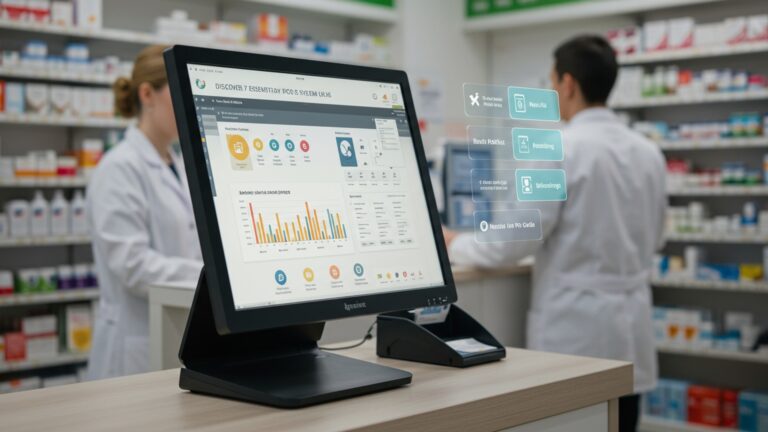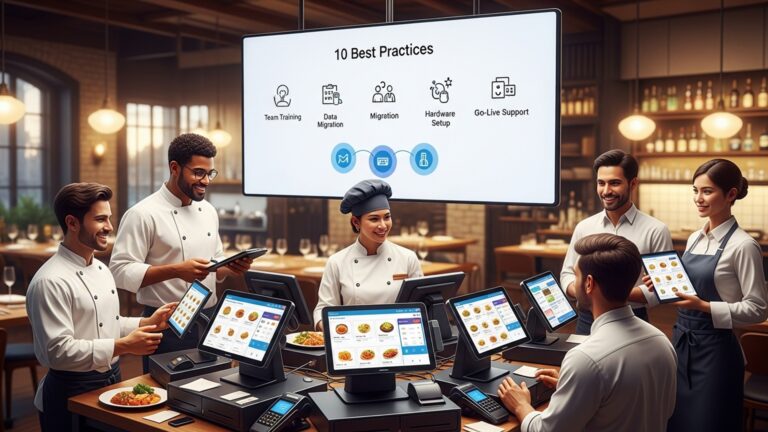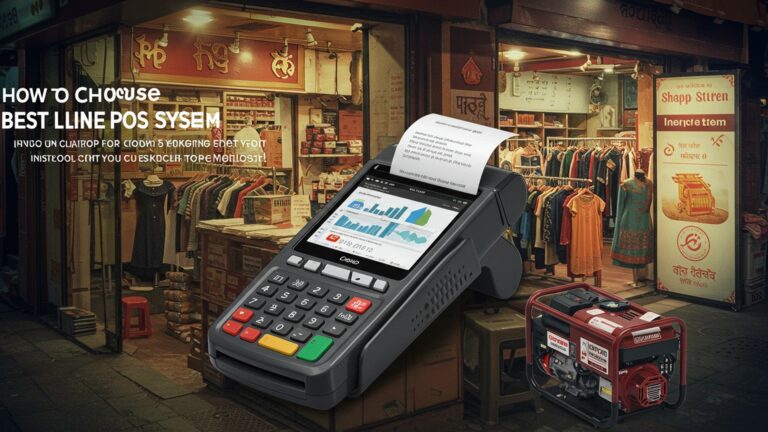Learn 5 Key Ways Restaurant POS Software Boosts Your Customer Service
In today’s competitive culinary landscape, discerning diners expect more than just exceptional cuisine; they demand seamless, personalized experiences from the moment they arrive. Modern customers prioritize efficiency as much as quality, making slow service or inaccurate orders immediate deterrents. Advanced Restaurant POS software has transformed beyond a simple transaction processor, evolving into a strategic operational backbone that significantly elevates every customer interaction. From expediting orders via integrated kitchen display systems to facilitating rapid, secure contactless payments and powering hyper-personalized loyalty programs, intelligent POS solutions provide the real-time data and operational agility necessary to exceed rising service expectations and cultivate lasting loyalty in a dynamically evolving market.
1. Expedited and Error-Free Order Taking for a Seamless Start
One of the most immediate and impactful ways Restaurant POS software transforms customer service is by streamlining the order-taking process. Gone are the days of handwritten tickets that could be misread, leading to frustration for both staff and patrons. Modern POS systems empower servers with intuitive interfaces, often on handheld devices, allowing them to input orders directly at the table.
- Enhanced Accuracy
- Increased Speed
- Easy Modifications and Upselling
When an order is digitally entered, the chances of misinterpretation are drastically reduced. Items are clearly listed, modifications (e. g. , “no onions,” “extra cheese”) are precisely recorded. dietary restrictions can be highlighted. This precision ensures that what the customer orders is exactly what they receive, minimizing costly mistakes and improving satisfaction.
Imagine a busy lunch rush. A server can take an order at Table 7, send it to the kitchen instantly. move on to Table 8 without needing to walk back and forth to a stationary terminal. This efficiency significantly cuts down wait times, allowing guests to enjoy their meals sooner and increasing table turnover for the restaurant.
Restaurant POS software often guides servers through menu options, suggesting modifiers or complementary items. This not only makes the ordering process smoother but also provides opportunities for upselling in a non-intrusive way, enhancing the customer’s experience by offering relevant additions.
For instance, consider a family dining at a popular Italian restaurant. With a traditional pen-and-paper system, a server might forget a specific modification for a child’s pasta dish or accidentally write down the wrong side order. With a robust Restaurant POS software, every detail is captured digitally, transmitted to the kitchen. confirmed, ensuring the family receives exactly what they wanted, leading to a much happier dining experience and fewer complaints.
2. Seamless Communication Between Front-of-House and Back-of-House
The synergy between the front-of-house (FOH) staff—servers, hosts—and the back-of-house (BOH) staff—chefs, cooks—is crucial for exceptional customer service. Restaurant POS software acts as the central nervous system, connecting these two vital operational areas and eliminating communication bottlenecks.
- Instant Order Transmission to the Kitchen Display System (KDS)
- Reduced Errors and Expedited Preparation
- Real-time Inventory and Availability Updates
As soon as a server confirms an order on their POS device, it’s instantly displayed on a KDS in the kitchen. This eliminates the need for printed tickets that can get lost, wet, or misread. Chefs see new orders, modifications. special instructions in real-time, allowing them to prioritize and prepare dishes more efficiently.
Clear, digital communication means fewer errors in the kitchen. When a customer orders a steak “medium-rare, no garlic butter,” the KDS clearly displays these instructions, preventing miscommunication that could lead to a re-fire and a frustrated customer waiting longer for their meal. This direct link between order and preparation significantly speeds up service delivery.
Some advanced Restaurant POS software integrates with inventory management. If a popular dish runs out of a key ingredient, the system can alert FOH staff in real-time, preventing them from taking orders that cannot be fulfilled and avoiding the awkward conversation of having to inform a customer that their desired dish is unavailable after they’ve already ordered it.
Imagine a busy Friday night. A server takes an order for a table of six. Without a POS, they might have to shout the order to the kitchen or wait for a busy chef to acknowledge a printed ticket. With Restaurant POS software, the order flashes up on the KDS immediately, categorized by course and table number, allowing the kitchen to start prep without delay. This orchestrated flow ensures food arrives hot, fresh. exactly as ordered, enhancing the overall dining experience.
3. Personalized Customer Experiences Through Data-Driven Insights
In an increasingly competitive market, personalization is key to fostering customer loyalty. Modern Restaurant POS software goes beyond transactions, capturing valuable customer data that enables establishments to offer truly bespoke experiences.
- Tracking Preferences and Order History
- Targeted Promotions and Loyalty Programs
- Enhanced Customer Relationship Management (CRM)
When customers opt into a loyalty program or provide their details, the POS can record their past orders, favorite dishes, preferred seating. even dietary restrictions. This data allows staff to anticipate needs. For example, a regular customer’s favorite coffee order might pop up when they check in, making them feel recognized and valued.
With purchase history at their fingertips, restaurants can create highly targeted promotions. A customer who frequently orders vegetarian dishes could receive a special offer on a new plant-based menu item, or a diner celebrating a birthday could automatically receive a discount through a linked loyalty account. This level of personalization resonates deeply with customers.
Many Restaurant POS software solutions include integrated CRM functionalities. This means that if a customer had a negative experience in the past, or if they are a VIP, notes can be attached to their profile, allowing staff to provide proactive service recovery or special attention. This demonstrates that the restaurant cares and remembers, turning a transactional interaction into a relationship.
Consider a scenario: Maria frequents “The Daily Grind” coffee shop. She always orders a large latte with almond milk. After a few visits, the barista, prompted by the Restaurant POS software, greets her by name and asks, “The usual, Maria?” This small gesture, enabled by data captured through the POS, makes Maria feel seen and appreciated, solidifying her loyalty to The Daily Grind over competitors. According to a study by Accenture, 91% of consumers are more likely to shop with brands that provide offers and recommendations that are relevant to them.
4. Efficient and Flexible Payment Processing
The final step in the dining experience—payment—can significantly impact a customer’s overall impression. Clunky, slow, or inflexible payment methods can sour an otherwise pleasant meal. Restaurant POS software excels in providing quick, secure. convenient payment solutions.
- Multiple Payment Options
- Table-Side Payments and Split Bills
- Enhanced Security and Transparency
Modern POS systems support a wide array of payment methods, including credit/debit cards (EMV chip cards), contactless payments (NFC like Apple Pay, Google Pay), mobile wallets. gift cards. This flexibility caters to diverse customer preferences, ensuring a smooth checkout process for everyone.
Handheld POS devices allow servers to process payments directly at the table. This means customers don’t have to wait for the server to take their card to a stationary terminal and return, speeding up the process. Moreover, splitting bills among large groups, once a complex and error-prone task, becomes effortless with POS software that can divide checks by item, evenly, or by specific customer requests.
EMV compliance and encryption built into Restaurant POS software protect customer financial data, reducing the risk of fraud. Digital receipts, often sent via email, provide clear transaction records, enhancing transparency and trust.
Imagine a group of friends celebrating a birthday, each wanting to pay for their own meal and drinks. Without a modern POS, this could be a logistical nightmare for the server, involving manual calculations and multiple card swipes. With Restaurant POS software, the server simply taps a few buttons on a tablet. the bill is accurately split, each person pays quickly. they can leave feeling satisfied, not frustrated by a drawn-out payment process.
5. Streamlined Problem Resolution and Feedback Management
Even in the best restaurants, issues can arise. How a restaurant handles these problems can define a customer’s experience. Restaurant POS software provides tools that empower staff to resolve issues quickly and effectively, often turning a potentially negative situation into a positive one.
- Quick Order Adjustments and Voids
- Efficient Returns and Exchanges
- Integrated Feedback Mechanisms
If a customer changes their mind, finds an error in their order, or needs an item removed, the POS system allows servers to make instant adjustments, voids, or comps directly from their device. This speed prevents delays and reduces the need for manager intervention for simple fixes, making the resolution feel immediate to the customer.
For retail components within a restaurant (e. g. , merchandise, packaged goods), the POS facilitates easy returns or exchanges, ensuring a hassle-free experience for the customer if they are not satisfied with a purchase.
Many advanced Restaurant POS software solutions include or integrate with customer feedback tools. This could be a tablet at the table for quick surveys, or a link on a digital receipt. By actively soliciting feedback, restaurants show they value customer opinions and are committed to continuous improvement. Addressing feedback directly and promptly can significantly improve customer loyalty.
Consider a diner who receives a dish they feel is undercooked. With a traditional system, the server might have to physically locate a manager, explain the situation. then wait for approval to re-fire or comp the item. With Restaurant POS software, the server can immediately process a “void” or “re-fire” order, send it to the kitchen. offer an apology or alternative to the customer without significant delay. This responsiveness demonstrates care and competence, transforming a potential complaint into an opportunity to show excellent service. As hospitality expert Danny Meyer emphasizes, “Hospitality is about making people feel good.” A POS helps operationalize that principle even when things go awry.
Conclusion
Ultimately, adopting modern POS isn’t just about streamlining orders; it’s a strategic investment in cultivating exceptional customer experiences. As I’ve observed across the industry, the true power emerges when you move beyond basic transactions. For instance, leveraging current trends like integrated loyalty programs allows you to surprise a regular with their preferred coffee order before they even ask, transforming a good visit into a truly memorable one. My personal tip? Fully empower your staff to utilize the system’s personalization features. A well-trained team, anticipating needs based on customer history—a significant recent development in service excellence—can significantly elevate satisfaction. Don’t just install; innovate. By thoroughly embracing these functionalities, you’re not merely serving meals; you’re crafting unique dining experiences that foster lasting loyalty and strategically position your brand for future success in a competitive market. For more insights on optimizing your restaurant’s digital footprint, consider exploring resources on effective restaurant technology implementation.
More Articles
How to Choose the Best Restaurant POS System
Unlocking Growth: The Power of POS Data Analytics
Mastering Your POS: A Guide to Effective Staff Training
The Future of Dining: Emerging Restaurant Technology Trends
The Benefits of Contactless Ordering in Modern Restaurants
FAQs
How does restaurant POS software actually make my customers happier?
It primarily speeds things up! From quick order taking to faster payment processing, a good POS system cuts down on wait times. This means your customers get their food and bill faster, leading to a much smoother and more enjoyable dining experience overall.
Can POS software help reduce mistakes with orders?
Absolutely! Digital order entry minimizes miscommunications between your waitstaff and the kitchen. Everything is clearly sent to the right place, which significantly reduces the chances of wrong dishes being served and keeps customers satisfied.
What about making customers feel special? Can a POS help with that?
Definitely. Many modern POS systems can track customer preferences, past orders. loyalty points. This allows your staff to offer personalized recommendations or remember a regular’s favorite drink, making them feel valued and encouraging repeat visits.
How does a POS help avoid those awkward ‘we’re out of that’ moments?
Great question! With integrated inventory management, your POS system knows exactly what’s available in real-time. If an item is running low or completely out, it can be automatically flagged or removed from the menu, preventing disappointment at the table.
Does this software just make things easier for my staff, or does it really impact the customer?
It does both. the impact on the customer is huge! By automating tasks like order entry and payment processing, your staff are freed up from manual work. This gives them more time to genuinely interact with customers, provide attentive service. focus on hospitality, which directly enhances the customer experience.
Can a POS help manage busy times better so customers aren’t waiting too long?
Yes, big time! Advanced POS systems often include table management features. These help you seat guests efficiently, manage waitlists. turn tables faster without making diners feel rushed. This means less waiting for your customers, even when you’re packed.
What if I want to know what my customers really think? Can a POS help with feedback?
Many modern POS solutions offer integrated feedback tools, like digital surveys or direct links on receipts. This makes it super easy for customers to share their thoughts, giving you valuable insights to continuously improve your service and show you care about their opinions.






